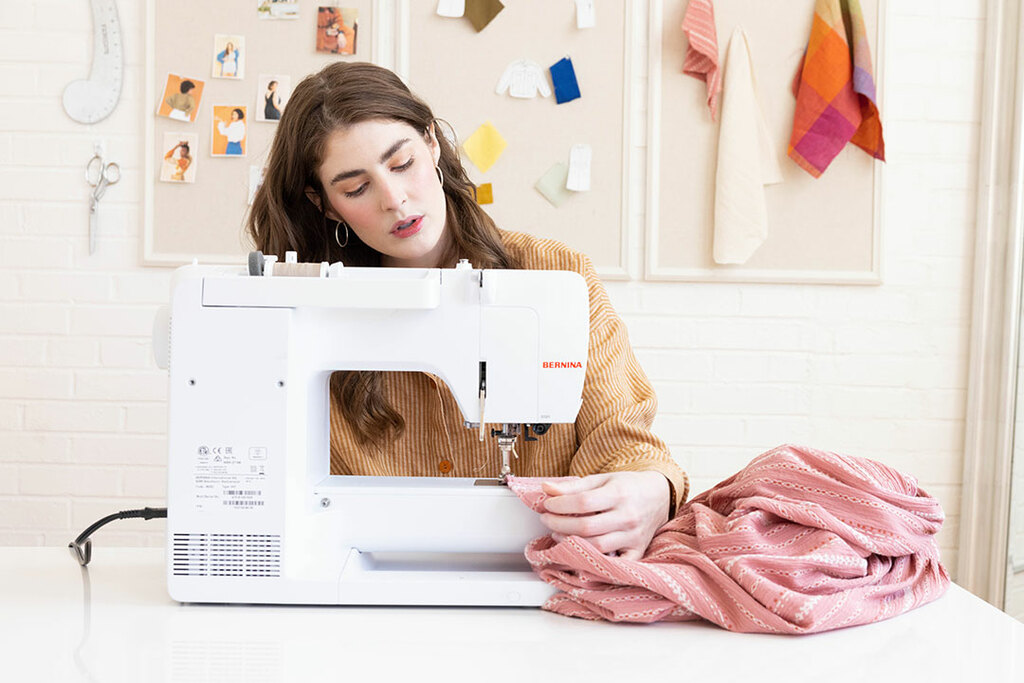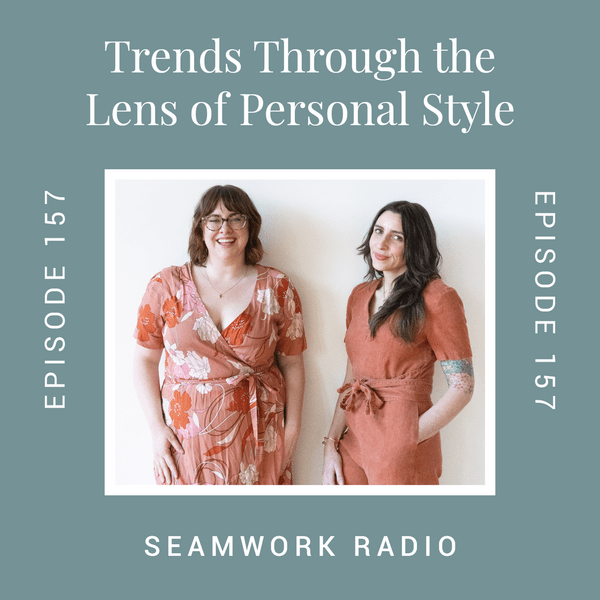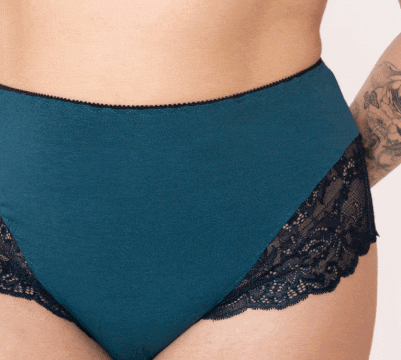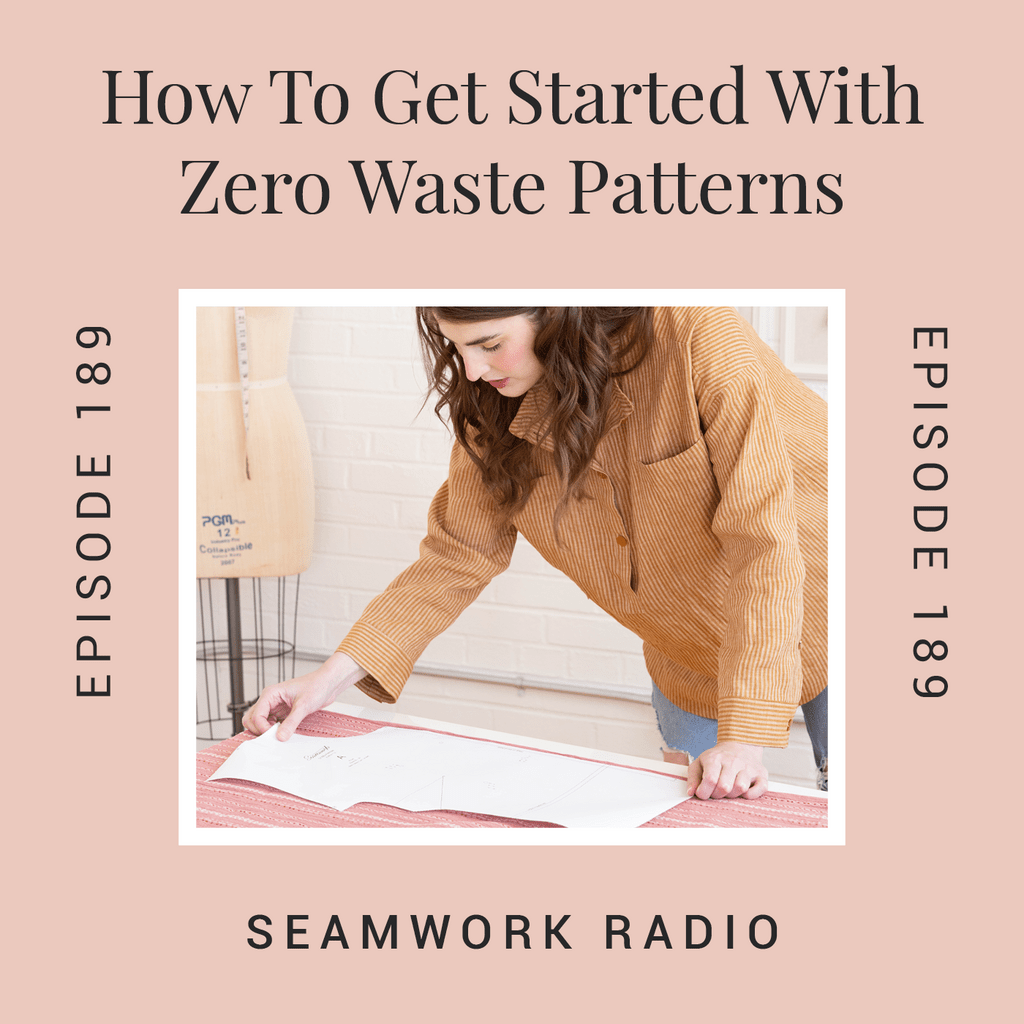You’ve been asking a lot of questions about zero-waste sewing patterns lately. The topic came up in our Design Your Wardrobe Office Hours sessions on Zoom, and we’ve seen a lot of posts in the Community.
So, are you new to zero-waste sewing? Are you thinking about trying a zero-waste pattern for the first time Or are you wondering if Seamwork will ever release a zero-waste pattern?
This week’s podcast answers all those questions.
Sarai and Haley discuss the benefits and limitations of zero-waste sewing and give eight simple steps for exploring this niche.
Below are the show notes for this podcast episode and a brief summary of what's covered, followed by a full transcript.
Show Notes
-
Holly McQuillan wrote Zero Waste Fashion Design -
Birgitta Helmersson has patterns and a Zero-Waste pattern book - Cindy from The Sew Sew
-
Liz Haywood has zero-waste patterns and books -
Fibr and Cloth. We’ve interviewed Alexis on the Seamwork Radio podcast! -
Cris Woods Sews has beginner-friendly, low-waste designs -
Design Your Wardrobe: Our popular course helps you plan the sewing projects you'll love to wear. -
Style Workshop: This hands-on workshop helps you define your core style. It's FREE for Seamwork members and just $10 if you aren't a member. -
Podcast listeners get half off an unlimited Seamwork membership when you use this link, plus you get to keep that price as long as you’re a member! - Tell us your idea for the next icebreakers for makers!

8 Simple Tips to Get Started With Zero-Waste Patterns
1. Educate Yourself on Zero-Waste Principles
Before you start sewing, do a little research and learn about what zero waste means. It helps to research why you might want to work with patterns that result in little to no scrap fabric and to learn about some of the designers who have become experts in this field.
2. Research Zero-Waste Designers
As you get started, look for sewing patterns specifically designed with zero-waste principles in mind.
Here are some recommendations from the Seamwork Community:
-
Holly McQuillan wrote Zero Waste Fashion Design -
Birgitta Helmersson has patterns and a Zero-Waste pattern book - Cindy from The Sew Sew
-
Liz Haywood has zero-waste patterns and books -
Fibr and Cloth. We’ve interviewed Alexis on the Seamwork Radio podcast! -
Cris Woods Sews has beginner-friendly, low-waste designs
3. Understand Pattern Layout
Zero-waste patterns often involve innovative techniques, such as folding, rotating, or tessellating pattern pieces, to use the entire fabric without leaving scraps.
Even if you don’t make a strictly zero-waste pattern, you’ll learn clever low-waste ways to lay out pattern pieces on the fabric.
4. Experiment with Fabric Manipulation
Learn fabric manipulation techniques that can help create interesting designs without the need for excess seams and fabric.
This includes techniques like smocking, pleating, and tucking.
These techniques add shaping to your garment. Zero-waste designs often have boxy silhouettes, and these fabric manipulation techniques allow you to adjust the fit.
5. Practice Sustainable Fabric Choices
If you aim to reduce waste, increase your sustainable impact by choosing eco-friendly fabrics.
Consider using organic cotton, linen, Tencel, or other environmentally friendly materials that align with the principles of zero-waste sewing.
You can also upcycle different textiles. The most sustainable choice is the one you already have in your closet or in your stash.
6. Take a Zero-Waste Sewing Class or Workshop
Taking a class will give you hands-on experience and guidance from instructors specializing in this area. Plus, you’ll meet some like-minded makers! You can also find tutorials online.
Choose a Zero-Waste Starter Project
Begin with simple projects to get a feel for zero-waste techniques. You can gradually take on more complex designs and projects as you gain confidence.
8. Make a Zero-Waste Sewing Plan
Once you have a taste for zero-waste sewing, consider how much you want to incorporate it into your sewing plans.
You might only want to make a few projects. Or, you might want to make it a larger part of your practice as a whole. You can set zero-waste goals that include working from your stash.
Plus, once you get familiar with the yardage needed for zero-waste projects, you’ll be able to buy exactly what you need for future projects.
Podcast Transcript
Sarai
I'm Sarai.
Haley
And I'm Haley.
Sarai
And this is Seamwork Radio.
Welcome back to Seamwork Radio, where we share practical ideas for building a creative process so you can sew with intention and joy. Today, we're talking about zero-waste sewing. We're going to cover the benefits and the limitations of zero-waste sewing, and we'll give you eight simple steps you can take if you want to start exploring this niche.
All right. We have an icebreaker today, Haley, from a community member from Tamac. I hope I'm pronouncing that correctly, Tamac. “What do you think is the most overrated sewing notion, and what do you think is the most underrated sewing notion?”
Haley
Okay. I'm going to go with something controversial for overrated. I hope I don't upset too many people, but I think overrated for me is the seam gauge.
I just feel like the gauge part of it always wears out really fast and gets loose and slides around. It drives me totally nuts. I've stopped using seam gauges and instead have started using a mini clear ruler, and it just works for me a lot better. It's a little bit more multi-purpose. I can use it to add seam allowances and make squared edges. That works for me a little better because I like a multi-purpose sewing tool. I'm a minimalist when it comes to my notions.
Then for underrated, I think there's a lot of things that are really simple things that are underrated, but I'm going to have to go with Wonder Tape, Washaway Wonder Tape, which is a brand name. I think it's the Clover brand. Basically, what it is, is a water-soluble adhesive tape. It's just really useful in so many different contexts. You can use it in place of pins for things that where pins might get in the way.
Some places I like to use it are for zippers. Sometimes when you're pinning a zipper, you can get weird, bumpy lines. Same with patch pockets. It's really great for. You can use it when you're attaching buttons. A little piece of wonder tape under your button. Shout out to Taylor. She was the one who turned me on to that. It comes in a little roll. I always have a couple of rolls of it because I feel like I just find new creative ways to use it all the time.
Sarai
Something similar is a glue stick. I think a glue stick can be really, really helpful for those same kinds of things that you were just talking about. Just for placing things temporarily. Use water-soluble glue and it washes right out. Great for zippers, buttons, all that stuff.
Haley
And you can make your mood board with it.
Sarai
Talk about multi-purpose. I think the most over... It was hard for me to think of an overrated sewing notion, but one sewing notion or a tool that I've had that I did not like are the seam rippers that are knife-shaped. That just looks like a hooked knife. I had one for a while. I know some people really love them, and I just did not like it at all. I ended up getting rid of it and replacing it with a traditional seam ripper.
I don't know if it's overrated because I know most people just use a traditional seam ripper, but some people love them, and I just do not.
Then as far as underrated, There are so many great tools you can use for sewing. But I think the one that I really love that I think is a little bit underrated is a magnetic pin cushion. I love having a magnetic pin cushion. I have one that I bought at the fabric store. This is a cute little purple one. It's sitting over there, and I was using that. And then my husband, Kenn, bought a bunch of little magnetic dishes just for parts to keep in the shop, and he had extra ones, and he gave them to me.
So now I have them scattered all over my sewing room. It's awesome because no matter where I am, if I'm at the cutting table pinning things, or if I'm at the sewing machine, wherever I am, I can just toss the pins towards the dish, and it's so fast.
Haley
The little dish ones are great. When I used to sew in a place where there was industrial sewing machines, they stick to the industrial sewing machines because they oftentimes have a magnetic bottom to them. If you sew on an industrial machine, I highly recommend those.
Sarai
That's a good tip. All right. Well, thank you for that icebreaker. If you have an icebreaker for us, you can leave it for us, and we'll probably use it on a future episode. If you're a Seamwork member, just go to seamwork.com/go/icebreakers, and that'll take you to a thread on our community where you can leave your question for a future episode.
All right, so let's talk about zero-waste sewing. In our recent Design Your Wardrobe Office Hours session that we had on Zoom, you guys had a lot of questions about zero waste patterns. We thought it'd be fun to give you some tips for getting into zero-waste sewing. A lot of these are taken directly from our community and from folks there who have experience with zero-waste sewing. I'm really excited to share them.
I'm also really excited just to learn from the people in the community about this topic, which I've dabbled in but don't have a ton of experience in myself. What about you? Have you ever used a zero-waste sewing pattern?
Haley
I've made a fair amount of zero-waste accessories, like zipper pouches and little things like that. I've made a couple of caftan-type dresses using the schematics, an illustration I saw online. I think that first when I was in school, I had to design something zero-waste at one point. I don't even... I think that I ended up making a boxy type top. I've done a little bit of zero-waste sewing here and there, but it's not something that I've incorporated as part of my everyday sewing ritual. What about you?
Sarai
Kind of similar. I haven't used a lot of zero-waste patterns per se, but I've made zero-waste garments. One that comes to mind is a camisole. Basically, it was just a ruffled tube with straps. It's really cute. I like it a lot. I saw a ready-to-wear version of it, and I recreated it. Because it's just a ruffled tube, it was a zero-waste pattern. I've done a few things like that, skirts, some real basic stuff like that. But I haven't gotten to more complicated zero-waste sewing.
But it's something I would like to try because I am very into using up the scraps that I have afterwards. I try to use that as much as possible and to waste as little fabric as possible. It's definitely something that I'm interested in.
Haley
Yeah, I will say that I am really... Even though most of my projects are not no waste, I am very conscious of the way that I lay out my patterns. I think something that people should recognize is that when you're following a pattern cutting layout, that that oftentimes is for a size range. You're following the cutting layout for 45-inch wide fabric for sizes double zero to eight.
If you are on the smaller end of that range, then you might be able to fit things in a little bit more economically. It's important to pay attention to those cutting layouts, especially the directionality of things and the number of pieces you're cutting. But you can fit a lot more stuff in there a lot of times.
I think that some of the lessons that I've learned along the way from my little experience with zero-waste sewing has really changed how I approach things. Those are some of the fun things this sewing niche.
Sarai, I want to talk about some of the limitations of zero-waste sewing. Which ones stand out to you the most?
Sarai
Well, I think there are some. They're not necessarily bad things, but there are some limitations to them. One of them is that zero-waste patterns often have a boxy fit, so they're not super fitted. Often, that's because you need those more rectangular pieces in order to use up all the fabric. If that's a look that you enjoy, then it might work for you.
But if you prefer a more fitted look, it's very hard to do that, or at least it's hard to recreate a lot of those styles in a zero-waste way.
I mentioned before that camisole that I made. One of the things you can do if you do like to show a little bit more shape than your traditional boxy fit, a camisole shows your shoulders, show some skin. You can strategically use the boxiness in certain places without swaddling yourself in fabric necessarily. That's one way you can work around it, but it is a little bit of a limitation, I think, with zero-waste sewing for clothing in particular. That's one. The other one, I would say, when it comes to zero-waste patterns that I've seen is just the size inclusivity because it's usually a one-size-fits-all deal.
Sometimes you aren't able to fit larger sizes on 45-inch fabric at all. So that can be a limitation as well. They're often one size fits all because that's how you can get all the pieces to fit together. It has to be a certain size in order to make that happen on a certain width of fabric.
Haley
Yeah, I think that's an interesting point. Something else, I think, that comes up with one size fits all is that every size is going It's going to fit everybody very differently or something that is graded and has multiple sizes and as the trade-off to that has some fabric waste to it, the pattern makers can do things to ensure that from size to size, that the look and proportions of the pattern are going to be more or less the same from body to body. It can be a limitation not just for people who are above a certain size, but also for people across all sizes.
Sarai
Yeah, that's very true, too.
Haley
But I think that there's totally exceptions to this. I know that there's zero-waste patterns out there that are more size-inclusive, and there are creative ways to make things less boxy, like elastic and pleats and other things, which we will definitely get into. But I think it is important to recognize some of the trade-offs that you make.
Sarai
Yeah, absolutely. Would you ever consider a zero-waste pattern for Seamwork?
Haley
I would consider it, but I think that the big limitation would be because at Seamwork, our current size range is for double zero to 30, which is a really large size range. I would only do it if I could do it in a way that would honor both ends of the size range and those who exist in between. But I would never say never.
Sarai
Yeah. I could see creative ways of doing that, but it It might be challenging.
All right. Well, let's talk about some of the tips. If you're interested in learning about zero-waste sewing or getting into it a little bit, I think there's a lot of great benefits to it. As I mentioned earlier, a lot of these ideas and tips came from our Community and from people who are really well-versed in zero-waste sewing. I'm excited to learn about this with you guys.
Number one, the first step in getting into zero-waste sewing, and this is something that you can start with if you're just dipping your toe in, is to just educate yourself on the principles of zero-waste sewing. Learning about what that means, what does zero-waste actually mean, and what are these principles and what do these patterns look like? It helps to research and understand why you might want to work with patterns that result in little or no scrap fabric and really investigate the reasoning behind it.
You might also learn some creative ways to minimize waste during the cutting and sewing process, even if you're not sewing with a zero-waste pattern in the future. That's a benefit of doing this initial research. Just doing that initial research on the reasoning behind zero waste will give you the context and the background that you need to get started.
Haley
Also, introduce you to some of the techniques that are commonly used, which can be a great jumping off point. I feel like after that, once you have a good understanding of this movement and some of its techniques and trademarks, the most accessible way I find to learn from a pro is to choose a pattern and get a little bit of first-hand experience with it.
Look for those sewing patterns specifically designed with zero-waste principles in mind. We got a whole bunch of recommendations from you all in the Community, which I'm going to list, but we will also put these in the show notes for you.
We have Holly McQuinnlyn, and I know that they have a book on zero-waste fashion design and also some patterns.
Birgita Helmerson, they have patterns and a zero waste book as well.
Cindy from the Sew Sew
Also Liz Haywood.
Fiber and Cloth. We actually interviewed Alexis here on the podcast. You can also listen to that episode if you want to learn more about her work.
Then lastly, Chris Wood Sows has a lot of really cool beginner friendly low-waste designs. I'm a big fan of their patterns. I think they're really cool.
Sarai
Yeah, those are some great recommendations. I'm glad we're going to put those in the show notes and people can check them out on their own because there's some really great ideas in there, great makers in there.
The next step is to understand a little bit more about pattern layout. So pattern layout is a really important part of zero-waste sewing. So It's really important to pay attention to how pattern pieces are laid out on the fabric when it comes to zero-waste sewing.
They often involve innovative techniques like folding or rotating or tessellating pattern pieces in order to use the entire fabric without leaving any scraps. Really understanding how those things work will be helpful to you because it's different from the kinds of sewing that you might be used to.
There might be some different techniques that you're not you're not used to doing that will help you to use up all that fabric. If you choose one of the patterns from one of those makers that we mentioned, that will really help you to get a head start on understanding these techniques.
Haley
Yeah, and getting that first-hand experience with those techniques. Our next tip is to experiment with fabric manipulation.
We're talking about fabric manipulation techniques that can help you create interesting designs and also things that can help you to create a little bit of extra shape. As we talked about earlier, sometimes this very specific silhouette that zero waste can lend itself to can be a drawback for some people. But there are some really great creative workarounds; you can do things like smocking, either by hand or like elastic smocking on your sewing machine, pleating, creating tucks, even darts, and different ways that you can create some shape in a garment without using excess fabric or having fabric waste are really great. Sometimes these are used in the context of creating shape, and sometimes they're just used to manipulate the shape of the garment in place of seams, really.
Sarai
Those are things you can carry into your other projects as well. If you learn a little bit more about how to create shape in a boxy, no-waste garment like this, that's something that you can then add to other garments that you're sewing in the future if you wanted to add a a little bit more shape, which is a nice side benefit.
The next tip is to practice sustainable fabric choices. When you're doing zero-waste sewing, you're oftentimes doing it in order to eliminate waste, obviously, and to make more sustainable choices. Learning a little bit about fabric and how to make sure that your materials are also sustainable can be really helpful in this endeavor.
You want to look for sustainable and eco-friendly fabrics, things like organic cotton or linen or Tercel or other environmentally friendly materials that really just align with the principles of zero-waste sewing. You can also upcycle different textiles. You can upcycle fabrics that you might already have.
I think one thing that's important to remember is following along with the principles of zero-waste sewing, it might help to eliminate waste to use something that you already have rather than buying something new just so you can make a zero-waste garment out of it.
Maybe that's self-evident, but to me, it seems more sustainable to use a fabric, even if it's not, you know, linen or hemp or something like that, and actually make use out of it rather than having it just sitting around, if you can create a zero-waste garment from it. I think that's a cool idea as well.
Haley
Yeah, as they say, the most sustainable option is the one you already have.
Sarai
Yeah, exactly.
Haley
All right. Our next tip is to, again, learn from the pros out there.
There are a lot of people who are really knowledgeable in this. Sarai and I are admittedly have dipped our toes in this pond, but there are a lot of classes and workshops out there, and there's nothing that can replace learning from a total pro at something. It can really provide you with the hands-on experience and guidance to become more specialized in this particular area.
Sarai
The next tip is, and I think this applies to anything that you're trying out for the first time, which is to start small and begin with simple projects to really get a feel for those zero waste techniques. Then as you gain confidence, you can gradually take on more complex designs and projects. I mean, this works for anything that you're just getting into. But I think for zero-waste sewing in particular, it can be a little bit intimidating to start with a big garment, and it can be a lot more manageable to begin with something small, like some of the projects Haley mentioned earlier, something very simple, like a pouch or something like that, to get a feel for it.
Haley
Our final tip is to really consider how much you want to incorporate it into your sewing plans and your sewing practice once you get a taste for that zero-waste sewing and its principles and techniques.
You might find that you really enjoy it, but you only want to make a few projects here and there, which is great. Or you might want to make it a big part of your sewing practice, which would be wonderful as well.
Or even if it's just taking some of those lessons that you've learned about more efficient layouts and creative shaping and then incorporating those into your regular sewing practice. I think everybody has different goals with their sewing. But for me, my goal is never perfection because I do think that that can be a really hard thing to hold yourself to. But any movement you can make towards improving the quality of your sewing, the wastefulness that you have in your sewing practice is always a major win.
Sarai
Yeah. I think another way that I could see zero-waste sewing being incorporated into your practice is if you discover a pattern or a way of sewing something that does produce zero waste. It's nice to have that in your back pocket so that you can go to the fabric store. If you do happen to find something that you love, you know exactly how much you need, and you know that you will use it all, and you can make something over and over again with a certain length of fabric. That's cool because that just provides you another option without having to think about what design you're going to make or how much you need. It's something nice to have in your back pocket, I think.
Haley
Yeah, that's such a great side benefit.
Sarai
Yeah. All right, well, let me recap the tips that we had for you today, many of these from our community.
One is to educate yourself on zero-waste principles and understand the context of zero waste sewing.
Then choose zero-waste patterns, and we gave you some options for that, which we'll link again in the show notes.
Three is to understand pattern layout and some of the different ways that patterns are laid out when it comes to zero-waste sewing.
Four is to experiment with fabric manipulation so you can add shaping where you want it.
Five is to practice sustainable fabric choices in addition to those sustainable patterns.
Six is to take a zero-waste sewing class or workshop if you'd like to dive deeper and learn a little bit more.
Seven is to start with small projects and begin there and then gain confidence over time.
Then eight is to consider how much you want to incorporate it into your ongoing sewing life.
All right. What's your big takeaway from this episode, Haley?
Haley
This got me thinking about when we were talking about limitations to zero-waste sewing, immediately, my mind started going to all of the different workarounds and creative ways that you could solve those limitations in a way or maybe make them less limiting to you. And it just made me think about how powerful sewing is and how much it allows us to think outside of, not just think outside of the box.
It does give us the knowledge to do that, but also to actually live outside of the box. And I just think that that's a really beautiful thing to have something in your life that gives you that mindset, that perspective shift that allows you to see limitations as creative opportunities.
Sarai
Yeah, that is such a good point. I think that's really cool. The different mindset that something like this provides, even within the context of sewing, which is already a different mindset, is really cool, and it stretches your imagination a little bit, which is really nice.
I think for me, what this brought up for me is I love this idea of having a zero-waste project in your back pocket, and especially, I think for something an accessory or something that could be a gift for others, I think that would be a really neat thing to have. That's something I'm going to investigate more because I could see that being something that I could incorporate into my sewing for years to come. That's a cool idea.
All right. Well, if you have more questions about zero-waste sewing, you can ask them in our Community. We've got a lot of knowledgeable people there who contributed to this episode.
We just have some of the nicest and most helpful sewers that you can imagine in the Seamwork Community. Our team, along with thousands of Seamworkers, are here to talk to you and to cheer you on every day. You can ask any question about sewing with absolutely no judgment and you'll always get some amazing answers.
You can also share your finished projects, and you can create your own goals, and we'll even email you reminders to keep you on track if you want that. It's the perfect place to go when you need a quick boost of creative energy.
If you liked this episode of the podcast, please consider leaving us a review. We love reading your reviews and getting those five-star ratings. It really helps other people to find the show as well. If you have a moment and you can leave us a review on Apple Podcasts or on Spotify or wherever you happen to be listening right now, we would super, super appreciate it.
You can also follow us on YouTube at Seamwork Video. You can follow us on Instagram at Seamwork. If you'd like to join Seamwork and become part of the private community I just talked about, plus get access to hundreds of sewing patterns and dozens of sew-along classes, our podcast listeners get a 50% off lifetime discount when you join at Seamwork.com/go/podcast50.
And that wraps us up this week. I'm Sarai.
Haley
I'm Haley.
Sarai
And this is Seamwork Radio.




